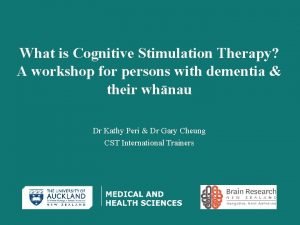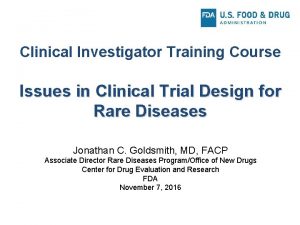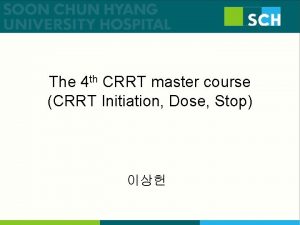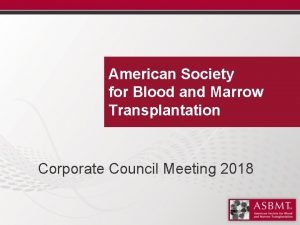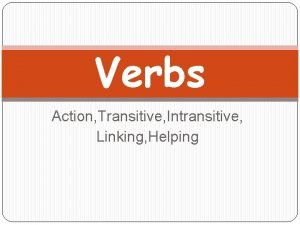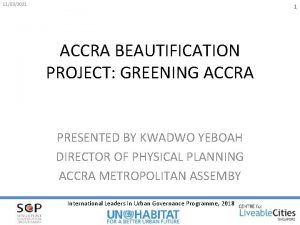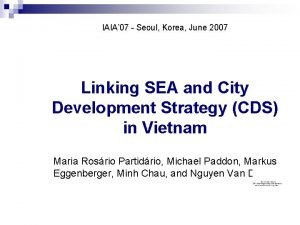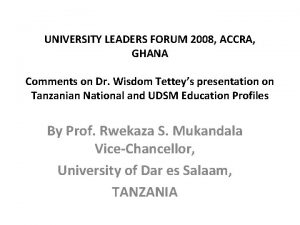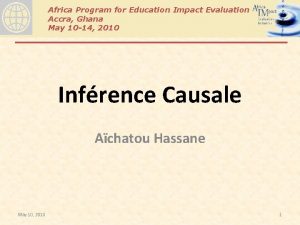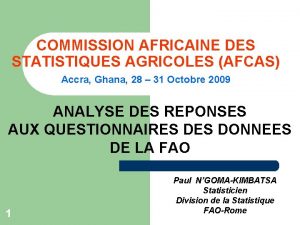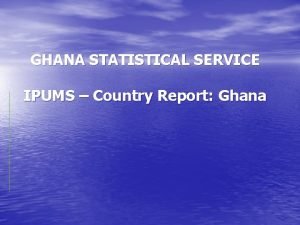Premeeting training course IAIA 09 Accra Ghana Linking







































- Slides: 39

Pre-meeting training course IAIA ’ 09 Accra, Ghana Linking Millennium Development Goals (MDGs) with biodiversity conservation and human well-being Dr. Asha Rajvanshi ar@wii. gov. in Professor & Head, EIA Cell Wildlife Institute of India, Dehradun

Evolution of MDGs UN Conferences: From Economic to Social • Int’l Conference on Population and Development (1994) • World Summit on Social Development (1995) • Fourth World Conference on Women (1995) • IDGs (1996) D E V E L O P M E N T

2000 Millennium Declaration ► All 189 UN Member States pledged to take concrete measures for judging performance through a set of inter-related commitments, goals and targets on development, governance, peace, security and human rights.

What are MDGs… ► The Millennium Development Goals (MDGs) are the world's time-bound and quantified targets for addressing extreme poverty. ► The MDGs are drawn from the actions and targets contained in the Millennium Declaration that was adopted by 189 nations and signed by 147 heads of states and governments during the UN Millennium Summit in September 2000. (Source: http: //www. unmillenniumproject. org/index. htm)

MDG: Goals & Targets 8 goals, o o 18 targets, 48 indicators Progress in achieving goals defined in terms of targets Monitoring progress through target-specific indicators Baseline Year= 1990 Target Year= 2015

The Millennium Development Goals

Goal 1 - Targets i. Halve, between 1990 and 2015, the proportion of people whose income is less than $1 a day ii. Halve, between 1990 and 2015, the proportion of people who suffer from hunger § In 2003, 1. 2 billion people were living in poverty (surviving on less than $1 a day). § More than 800 million people are malnourished. § Malnutrition causes more than half of all child deaths. § An estimated 82 million people in the developing world were affected by chronic hunger in 2003. Source: THE MILLENNIUM DEVELOPMENT GOALS REPORT 2006

Goal 2 - Targets i. Ensure that, by 2015, children everywhere, boys and girls alike, will be able to complete a full course of primary schooling § Globally, more than one in five girls of primary-school age are not in school, compared to about one in six boys. § Oceania, Western Asia and Southern Asia are the regions where the gender gap is most evident. § 80 per cent of the world’s out-ofschool children live in sub-Saharan Africa and Southern Asia Changes in primary completion rates across subregions http: //www. uneca. org/cfm/2008/docs

Goal 3 - Targets i. Eliminate gender disparity in primary and secondary education preferably by 2005 and in all levels of education no later than 2015 A one-year increase in the schooling of all adult females in a country is associated with: $700 increase in GDP per capita, 1. 4 percent reduction in children’s labor force participation, (Source: UNFPA State of the World Population, 2004) 3. 7 percent increase in access to safe water and 5. 4 percent to sanitation. (Source: World Bank)

Goal 4 - Targets i. Reduce, by two-thirds, between 1990 and 2015, the under-five mortality rate § 11 million children die each year before they reach the age of five, in most cases by easily treatable diseases. § 20% of child deaths in developing countries are caused by preventable acute respiratory infections. § 30 million children worldwide do not receive vaccinations for easily preventable diseases. Source: www. anausa. org

Goal 5 - Targets i. Reduce by three-quarters, between 1990 and 2015, the maternal mortality ratio Deaths attributable to environmental causes Indoor smoke from solid fuels Urban air pollution Unsafe water, sanitation and hygiene Male Female (Source: WHO World Health Report 2002) Mothers and children are the main victims of the poisonous chemicals in smoke from kerosene and wood-burning stoves, which kill almost 1. 5 million people a year worldwide. In 2000, 917 mothers died in Africa for every 100, 000 live births and, for 18 countries, the maternal mortality rate was over 1, 000 per 100, 000 live births.

Goal 6 - Targets i. Stop and reverse the spread of HIV/AIDS ii. Stop and reverse the incidence of malaria and other major diseases by 2015 § In 2002, 42 million adults and 5 million children were living with HIV/AIDS, over 95% of them in developing countries (70% of them in sub-Saharan Africa). § In 2003 alone, 3 million people died from AIDS; since 1996 over 20 million people have died. § By 2010, the number of children who have lost one or both parents to AIDS is expected to reach 25 million. § Tuberculosis is the leading infectious killer of adults and kills almost 2 million people a year; malaria kills more than 1 million people a year. § In 2000, 17 million people in Africa were affected with both HIV and tuberculosis simultaneously. Source: www. anausa. org

Goal 7 - Targets i. Integrate the principles of sustainable development into country policies and programs and reverse the loss of environmental resources ii. Halve, by 2015, the proportion of people without sustainable access to safe drinking water § Six to seven billion tons of carbon dioxide produced by human activity is released into the atmosphere each year. § Total forest land shrank by 94 million hectares (232 million acres) in the last decade and now covers only about 30% of all land. § 2. 4 billion people lack access to improved sanitation. Source: www. anausa. org

Goal 8 - Targets i. Develop an open, rule-based, predictable, non-discriminatory trading and financial system ii. Address the special needs of the least developed countries iii. Address the special needs of landlocked countries and small island developing states iv. Deal comprehensively with the debt problems of developing countries through national and international measures v. Provide access to affordable, essential drugs in developing countries vi. Make available the benefits of new technologies, especially information and communications technologies § Assistance from developed countries decreased by a third in the 1990 s. § In 2001, landlocked countries received only 6% of all official development assistance. § In 2002, 74 million young people (15 to 24) were unemployed. They account for 41% of unemployed people globally. Source: www. anausa. org

MDG: Essential Values o o o Freedom Equality Solidarity Tolerance Respect for nature Shared responsibility

MDGs: Why do they matter? ► They are the first set of quantitative and time-bound goals shared by developing and developed countries. ► They offer an integrated, goal-oriented framework for poverty reduction. ► They form the basis on which to mobilize resources for investing in human development. ► At the country level they provide a platform for discussion and advocacy.

What do MDGs offer ? i. An unparalleled opportunity to make the world a better place. ii. A formal recognition that poverty can be solved when both the rich and poor work together. iii. A practical and achievable set of targets for human development up to 2015. “a once-in-a generation chance to bring about historic, fundamental change. . . ” Kofi Annan, Secretary-General United Nations

Relating the MDGs to: Human Development Environment Biodiversity

Human development and MDGs Measures and concepts Two aspects -Process of widening people’s choices -Level of their achieved well-being Two sides -Capabilities: Formation of human capabilities -Opportunities: Use of the acquired capabilities Dimensions • Long and healthy life • Knowledge • Decent standard of living • Participation or exclusion Human beings are the participants in the development process (concept of human development) and not just …beneficiaries (human welfare approach)

Environment & the MDGs o Environmental sustainability Development cannot be sustained for long at the cost of environmental degradation o One specifically stated goal that cuts across all goals Essential ingredient for achieving all the other MDGs

How biodiversity can contribute to the MDGs Example of biodiversity factors Ecological integrity Ecosystem approach to conservation Access to resources Dimensions of poverty Vulnerability to biodiversity loss (incl. food and nutritional securities) Access to income and resources Benefit sharing In-situ conservation Sustainable use Environmental management Life insurance policy for life Health, sanitation, energy, water and governance Elements of well-being Development goals Eradicate extreme poverty and hunger Food security Enhanced livelihood security Reduced health risk Reduced vulnerability Achieve universal primary education Promote gender equality Reduce child mortality Improve maternal health Combat major diseases Ensure environment sustainability Global partnership for development (Source: IIED, 2004)

Linking biodiversity, poverty and the MDGs Millennium Development Goals are targeted to eradicate extreme poverty Poverty is about deprivation in human well-being Biodiversity is the foundation for human well-being MDGs contribute in improving § economic capabilities § human capabilities § political capabilities (rights, influence and freedom), § socio-cultural capabilities (status and dignity), § protective capabilities (to address security, risk and vulnerability). Human well-being is “Freedom of choice and action based on improved security, health, good social relations, and basic material for a good life” (Source: Ash and Jenkins, 2007)

How environment and poverty nexus affect biodiversity? Environmental degradation Degradation of biodiversity resources Poverty forces over exploitation of natural resources (accelerating the process of ecological degradation) Degraded resource pool limits choices (affecting resource availability, nutrition, income and vulnerability) Poverty

Revisiting the goals

Goal Poor people’s livelihoods, food and health security often depend on ecosystems goods and diversity of services they provide Intensive use of ecosystems can erode ecosystems through soil degradation, water depletion, contamination, collapse of fisheries, or biodiversity loss. Investments in ecosystem service maintenance and restoration can enhance rural livelihoods and be a stepping stone out of poverty http: //www. monash. edu. au/pubs/monmag/i ssue 18 - 2006/assets/images/africans. jpg sitemaker. umich. edu/356. cho/files/hunger. jpg

Goal Increased dependence on biodiversity for sustenance leads to increased physical burden. Decline in biodiversity resources limits options of livelihood for the poor. Natural disasters linked to biodiversity loss and impairment of ecosystem services reduce children’s available time and access to education opportunities. www. unops. org/. . . /AFO/Africa-No. -2 -041. jpg Education will improve the human resources capital, encourage alternative income options and thereby reduce dependence on biodiversity resource based subsistence

Goal Impacts of environmental degradation often fall more on women and girls who are more exposed to indoor air pollution from burning of fuel wood and other biomass and carry heavy loads of fuel wood and water The increased time spent in attending to household chores limits their opportunities for education, literacy and income generating activities. Higher household incomes and education for mothers doubles child survival In Chad and Nigeria, children of educated mothers are two to four times more likely to be vaccinated than children of uneducated mothers www. reformsnetwork. org/women/documents/GAWE%2 Securing women’s rights and access to natural resources, giving a fair share of the benefits from their knowledge and providing them with capacity-building support can help empowering women

An average household spends 1 hour and 40 minutes each day for collecting water in Kenya, Uganda and Tanzania. . (Source: IIED 2002). Average time spent on collecting fuelwood and fodder by women in the hill areas in India is about 4 to 6 hours per day respectively. (Source: Saksena et al. , 1995). Percentage of the population who must travel more than 30 minutes to fetch water (Source: WHO World Data Table)

Goal Many diseases (e. g. malaria) are known to flare up in ecological systems which have their regulation component altered by irrigation projects , dams, construction sites, standing water and poorly drained areas. Saudi Arabia, the Gulf States, Jordan and Tunisia are the highestranking countries, where approx. 90 mothers die per 100 000 live births. New biodiversity-derived medicines hold promise for fighting major diseases! http: //mdgs. un. org/unsd/mdg/Re sources/Static/Products/Progress 2006/MDGReport 2006. pdf flickr. com/photos/mickyates /35146744/

Goal Ecosystem services such as food production, water purification, and disease regulation are vital in reducing child mortality. Degradation of ecosystems can influence the abundance of human pathogens resulting in outbreaks of diseases such as malaria and cholera, and the emergence of new diseases. Wide range of plants contribute to dietary diversity, nutritional well-being and traditional sources of medicines. Scientists have identified more than 2, 000 tropical plants as having anti-cancer properties (GEF ). Some 80 per cent of the world’s people rely on traditional health care systems that use traditional medicines, derived from plants (Source; WHO 2005). Some 50, 000 of the world’s plant species are used in traditional medicine (WWF). That the strongest link between people and nature is for medicinal plants and that is why these resources need to be carefully managed

Goal Biodiversity buffers humans from organisms and agents that cause disease. By diluting the pool of virus targets and hosts, biodiversity reduces their impact on humans and provides a form of global health insurance. At the same time, intrusion into the world’s areas of high biodiversity disturbs these biological reservoirs and exposes people to new forms of more virulent disease organisms including SARS, Ebola, malaria, and the HIV pandemic. Prevalence of HIV (%population age 15 -49) Source: The World Bank Group ( 2004) http: //www. unaids. org/unaids_resources/2006 GRi mages/GR 06 -C 2147 -06. jpg Preventing emerging diseases through biodiversity conservation is far more cost effective than developing vaccines to combat them later.

Goal Biodiversity and healthy ecosystem services increase resilience to economic shocks and environmental changes and provide a natural defenses against environmental disasters. Ecosystem depletion and species extinction reduce the capacity to respond to future environmental stresses including water scarcity and climate change. Drought-resistant crops are known to reduce the likelihood of famines triggered by lack of rainfall. Mangroves provide shelter against an increasing number of typhoons and floods. Biodiversity resources can reduce the impacts of climate change on people and production

Goal The complex interactions between human well-being, ecosystem services and biodiversity requires an integrated approach including partnerships between rich and poor countries. (The World Bank group, 2004) Conserving habitats which support biodiversity is necessary for strengthening the capacity of governments to eradicate poverty, improve maternal health, and reduce child mortality.

Links between climate change and MDGs: The role of biodiversity Changes in climate Increased temperature and changes in precipitation reduces diversity of natural resources Change in precipitation, run-off variability leads to changes in water table and related stress (e. g. drought, desertification) Increased incidence or intensity of climate related disasters leads to damage to infrastructure Temperature, water and vegetation changes contribute to variations in food and biomass productivity Increasing vulnerability of the poor LESS SECURE LIVELIHOODS (due to depletion of natural resource forced displacement of people to pristine areas) Role of biodiversity Conservation of trees can reduce the amount of CO 2 released into the atmosphere and improve local hydrology INCREASED HEALTH RISKS (due to increased physical burden, malnutrition and exposure to vectors of diseases) Conservation of mangroves and drought resistant crops can reduce climate change effects such as flooding and famine CONSTRAINED ECONOMIC OPPORTUNITIES (due to changes in resource base for consumptive and economic benefits) Sustainable use of biodiversity can strengthen ecosystem resilience and productive enterprises Impacts of Millennium Development Goals Goal 1: Eradicating poverty and hunger Goal 2: Achieve Universal Primary Education Goal 3: Promote Gender Equality Goal 4: Reduce Child Mortality Goal 5: Improve Maternal Health Goal 6: Combat Major Diseases Goal 7: Ensure environmental sustainability Goal 8: Promote Global Partnership

Looking ahead… “For everyone on Earth, the Millennium Development Goals are a linchpin in the quest for a more secure and peaceful world. . . ” Jeffrey D. Sachs, Director Millennium Project § § § PROMOTE upstreaming of biodiversity in development actions for economically and environmentally secure and peaceful world. USE MDGs as an opportunity to translate the recognition of the importance of biodiversity into tangible and visible outcome for sustainable development. CONTRIBUTE to the capacity building efforts to identify critical links between biodiversity and human actions to harmonize development goals with the human well being.

Further reading Ash, N. and Jenkins, M. (2007). Biodiversity and Poverty Reduction. The Importance of Biodiversity for Ecosystem Services. United Nations Environment Programme World Conservation Monitoring Centre (UNEP-WCMC) Publication. Cambridge, U. K. Biodiversity, nutrition and health: making a difference to hunger and conservation in the developing world. Keynote Address to the Seventh Meeting of the Conference of the Parties to the Convention on Biological Diversity (COP 7) Chivian, E (Ed. ) (2002). Biodiversity: Its Importance to Human Health. Centre for Health and the Global Environment Harvard Medical School, Harvard. Frison, E. A. , Cherfas, J. , Eyzaguirre, P. B. , Johns, T. (2004). Biodiversity, Nutrition and Health: Making a difference to Hunger and Conservation in the Developing World. IPGRI and CBD Publication. GEF (2005). Achieving the Millennium Development Goals. A GEF progress report. Global Environment Facility. Washington, DC, U. S. A. IIED (2002). Drawers of water II. In: Collaboration with Community Management and Training Services Ltd. (Kenya). Institute of Resource Assessment of the University of Dar es Salaam (Tanzania) and Child Health of Makerere University Medical School (Uganda). London. Millennium Ecosystem Assessment (2005). Ecosystems and the human well-being: Biodiversity Synthesis. Old Resource Institute, Washington, DC.

Saksena, S. , Prasad, R. and Joshi, V. (1995). Time Allocation and Fuel Usage in Three Villages of the Garhwal Himalaya, India. Mountain Research and Development, 15(1), 57 -67. UNFPA (2004). State of World Population 2004. The Cairo Consensus at Ten: Population, Reproductive Health and the Global Effort to End Poverty. United Nations Population Fund, New York, U. S. A. United Nations Association of the USA and the Business Council for the United Nations www. unausa. org WHO (2002). The World Health Report 2002: Reducing Risks, Promoting Healthy Life. World Health Organization, Geneva, Switzerland. WHO, UNICEF and UNFPA (2003). Maternal Mortality in 2000: Estimates Developed by WHO, UNICEF and UNFPA. World Health Organization, Geneva, Switzerland. http: //www. moiti. org/pdf/Brazil%20 Health%20 Care%20 System. pdf http: //www. undp. org/mdg http: //www. un. org/millenniumgoals/ http: //mdg_guide. undp. org

http: //mdg_guide. undp. org F. SERENIUS and Y. HOFVANDER 2008 The Ecological Context of Child Health in Saudi Arabia Acta Pediatric Volume 77 15 - 28 UNDP (2003 b) The Millennium Development Goals in Arab Countries (New York: United Nations Development Programme). Kingdom of Saudi Arabia Millennium Development Goals 1425 H 2005 G Ministry of Economy and Planning United Nations Development Program

Thank you all…
 Wang xiaomin
Wang xiaomin How to install a lintel in a single brick wall
How to install a lintel in a single brick wall Course number and title
Course number and title Course interne course externe
Course interne course externe Cognitive stimulation therapy training course
Cognitive stimulation therapy training course Module 7 weights and measures
Module 7 weights and measures Da form 5434 army career tracker
Da form 5434 army career tracker Training for adventurer
Training for adventurer Cabin crew course in malaysia
Cabin crew course in malaysia Defensive driving training course ppt
Defensive driving training course ppt Cognitive stimulation therapy training course
Cognitive stimulation therapy training course Fda clinical investigator training course
Fda clinical investigator training course Autotransfusion training course
Autotransfusion training course Colistin crrt dose
Colistin crrt dose Itcso
Itcso Crrt training course 2020
Crrt training course 2020 Pto course
Pto course Pfmeas
Pfmeas Asbmt clinical research training course
Asbmt clinical research training course Bank reconciliation training course
Bank reconciliation training course Analytical thinking training course outline
Analytical thinking training course outline Responsible beverage course
Responsible beverage course Accounts payable training course
Accounts payable training course Tmva courses
Tmva courses Vcp training course
Vcp training course Training is expensive without training it is more expensive
Training is expensive without training it is more expensive Metode of the job training
Metode of the job training Aggression replacement training facilitator training
Aggression replacement training facilitator training Essay linking words
Essay linking words Linking vowel to vowel examples
Linking vowel to vowel examples Is feel a linking verb
Is feel a linking verb Transitive and intransitive and linking verbs
Transitive and intransitive and linking verbs Action linking helping verbs
Action linking helping verbs Verb notes
Verb notes Linking words comma
Linking words comma Absolute loader advantages and disadvantages
Absolute loader advantages and disadvantages Intervening prepositional phrases
Intervening prepositional phrases List of linking verbs
List of linking verbs Define linked object
Define linked object That + verb
That + verb




